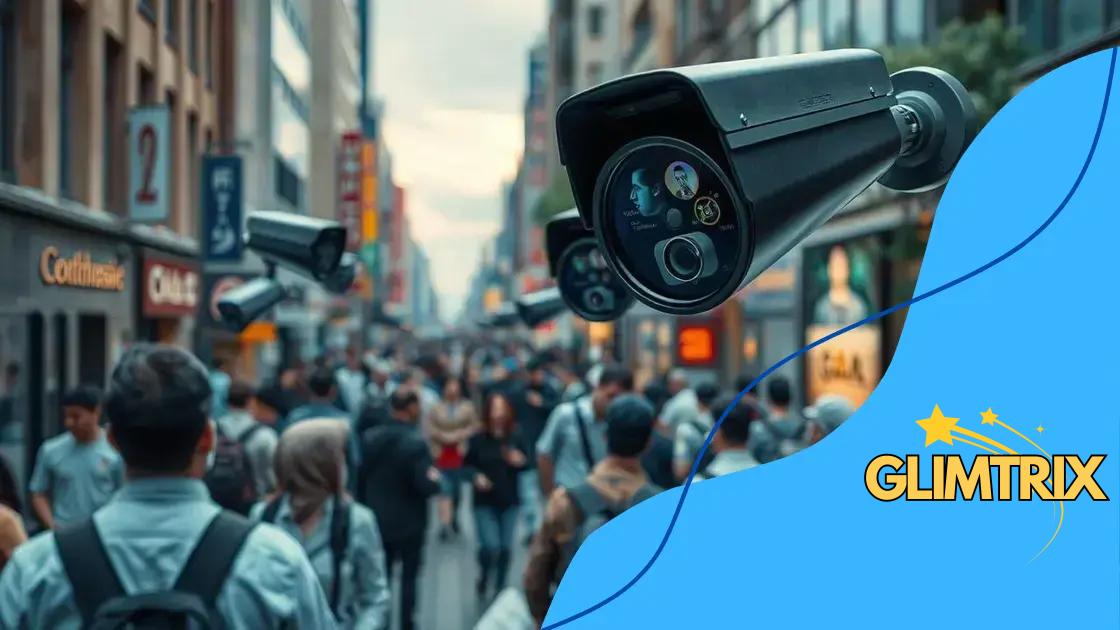The role of facial recognition in enhancing public safety

The role of facial recognition in enhancing public safety includes improving security at events, aiding law enforcement, and ensuring swift identification of individuals, though it raises ethical and privacy concerns that must be managed.
The role of facial recognition in enhancing public safety is becoming increasingly significant in our daily lives. Have you noticed how often this technology pops up in security settings? Let’s delve into its impact and find out just how this technology shapes our safety.
Understanding facial recognition technology
Facial recognition technology is a remarkable advancement in the field of security and surveillance. By analyzing unique facial features, this technology can accurately identify individuals in real-time. It has become widely adopted across various sectors, enhancing safety protocols significantly.
How Does Facial Recognition Work?
The core of facial recognition technology lies in its ability to capture and process images. Cameras record the facial characteristics, focusing on key points like the distance between the eyes and the shape of the jaw.
Key Steps in Facial Recognition:
- Image Capture: High-quality images are taken from various angles.
- Face Detection: Algorithms identify and isolate the face within the image.
- Feature Extraction: Unique identifiers are extracted from the face.
- Comparison and Matching: The extracted data is compared against existing databases.
As more organizations adopt this technology, the demand for efficient and reliable systems increases. This trend is evident in law enforcement, where facial recognition can help locate criminals faster than traditional methods. With features improving constantly, the effectiveness of these systems becomes evident.
However, the ethical implications of using facial recognition technology cannot be ignored. Privacy concerns arise as individuals may not always consent to having their faces scanned. Highlighting this balance is crucial as we integrate this powerful tool into our daily lives.
Overall, facial recognition technology is evolving rapidly, and its potential benefits in enhancing public safety are profound. As advancements continue, understanding its mechanisms will be essential for individuals and organizations alike.
Key benefits for public safety
The integration of facial recognition technology offers several key benefits for public safety. It significantly enhances security measures and helps authorities respond efficiently during emergencies. With the capability to quickly identify individuals, this technology empowers law enforcement and boosts overall community safety.
Immediate Identification
One key benefit of facial recognition technology is the ability to identify suspects quickly. This can be crucial in high-pressure situations, such as active investigations or emergency responses. By matching facial features against databases, authorities can swiftly locate and apprehend individuals who pose a threat.
Crime Prevention
Moreover, facial recognition serves as a deterrent for potential criminals. Knowing that surveillance is in place often discourages illegal activities. When individuals realize that they can be easily identified, they may think twice before committing a crime. This leads to safer environments in public areas.
Enhanced Situational Awareness
Facial recognition technology improves situational awareness for security personnel. By using this technology in crowded spaces, authorities can track movements and detect suspicious behaviors effectively. This proactive approach enables better management of resources and quicker responses to potential threats.
- Faster Investigations: Access to instant identification helps solve cases more rapidly.
- Reduced Response Time: Authorities can act swiftly based on reliable data.
- Accurate Reporting: Improved data collection leads to better crime analysis.
As communities embrace facial recognition, public safety strategies evolve. This technology’s efficiency and reliability empower law enforcement agencies, allowing them to prioritize resources effectively and ensure the safety of citizens. By leveraging the benefits of this technology, society can create environments where safety is prioritized, ultimately fostering trust between the community and law enforcement.
Real-world applications and examples

Facial recognition technology has found its way into various sectors, demonstrating its usefulness in real-world applications. From enhancing security at events to aiding in crime prevention, this technology is reshaping how communities ensure safety. Its versatility makes it an essential tool for modern law enforcement.
Security at Public Events
One significant application of facial recognition technology is in managing security at large public gatherings. Concerts, sports events, and festivals often attract massive crowds, making it vital to monitor movements effectively. By deploying facial recognition systems, security teams can quickly identify individuals on watchlists, enabling rapid responses to potential risks.
Police Work and Investigations
Law enforcement agencies are increasingly using facial recognition in their investigative processes. This technology allows officers to match surveillance footage with databases of known offenders. As a result, cases that once took considerable time to solve can now be addressed more efficiently.
Real-World Success Stories
Several cities around the world have successfully implemented facial recognition systems. For instance, in the UK, some transportation hubs utilize this technology to enhance security. By monitoring faces on buses and trains, authorities can identify suspects swiftly. Similarly, cities like New York have adopted this technology within their policing strategies. It helps in keeping communities safer by preventing crime before it occurs.
- Airports: Facial recognition is used for seamless passenger identification during check-ins and boarding.
- Retail Security: Stores use this technology to identify potential shoplifters and enhance customer experiences.
- Border Control: Many countries have adopted facial recognition for cruisers entering and exiting borders.
Overall, the real-world applications of facial recognition technology are extensive and varied. As these systems evolve, they will continue to enhance public safety and security efforts across multiple domains.
Ethical considerations in facial recognition
As facial recognition technology grows more prominent, it raises important ethical considerations. While it offers significant benefits, it also presents challenges regarding privacy and individual rights. Understanding these implications is crucial in shaping how we use this technology responsibly.
Privacy Concerns
One of the primary ethical issues surrounding facial recognition is the invasion of privacy. Many people are unaware that their images may be captured and analyzed without their consent. This can lead to a sense of being constantly watched, even in public spaces where individuals expect some level of anonymity.
Potential for Misuse
The potential for misuse of facial recognition technology also raises alarms. Law enforcement agencies might abuse it to target specific groups or individuals without sufficient justification. Such actions can lead to wrongful accusations and disproportionate surveillance, particularly against marginalized communities.
Bias and Accuracy
Another ethical consideration is the accuracy of facial recognition systems. Studies have shown that these technologies can exhibit bias, particularly against people of color and women. Disparities in recognition accuracy can result in unfair treatment by law enforcement and other authorities.
- Transparency: Users and those impacted by the technology should understand how it works and the data being collected.
- Regulation: Proper guidelines are necessary to ensure responsible use and to protect individual rights.
- Accountability: Organizations using facial recognition must be held accountable for their actions and decisions regarding its use.
In addressing these ethical concerns, stakeholders must balance the benefits of facial recognition technology against potential risks. Engaging in public discussions about its use can foster transparency and build trust between communities and authorities.
Future trends and challenges
The future of facial recognition technology holds great promise, but it also poses several challenges. As this technology evolves, staying informed about its trends is essential. This awareness will help us navigate the opportunities and hurdles that lie ahead.
Emerging Technologies
One of the significant future trends is the integration of artificial intelligence (AI) with facial recognition systems. This combination will enhance accuracy and streamline processing speed. AI can help analyze vast amounts of data, making systems smarter. More advanced algorithms will continuously improve the algorithms used for recognition, allowing for more precise identifications.
Increased Regulation
With the benefits come challenges, including the need for increased regulations. Governments and organizations will need to establish guidelines to govern the ethical use of facial recognition technology. Striking a balance between innovation and privacy will be crucial. Proper regulations will help prevent misuse, ensuring that individual rights are protected while optimizing public safety.
Public Perception and Trust
As facial recognition becomes more prevalent, building public trust will be fundamental. Many individuals remain skeptical about how their data is used and stored. Transparency in how facial recognition is implemented can alleviate concerns. Regular communication about security measures and data protection will enhance public confidence in this technology.
- Data Security: Ensuring that collected data remains secure from breaches is critical for protecting individual privacy.
- Addressing Misuse: Developing systems to prevent unauthorized access and abuse of facial recognition technology is necessary.
- Bias Mitigation: Ongoing efforts to improve accuracy across diverse populations will help reduce bias in facial recognition systems.
Overall, the future of facial recognition technology is filled with potential, but it requires careful management to address its challenges. Collaborative efforts among technologists, legislators, and the public can guide its path forward.
FAQ – Frequently Asked Questions about Facial Recognition Technology
What are the main benefits of facial recognition technology?
Facial recognition technology enhances public safety by improving security at events, aiding law enforcement in investigations, and monitoring crowded areas effectively.
How does facial recognition affect privacy?
Facial recognition can raise privacy concerns as it may capture and analyze individuals’ images without their consent, leading to feelings of constant surveillance.
What ethical issues surround the use of facial recognition?
Key ethical issues include potential misuse of data, biases in recognition accuracy, and ensuring responsible and transparent use of the technology.
What future trends can we expect in facial recognition technology?
Future trends include advancements in AI integration, increased regulations to protect privacy, and efforts to improve public trust through transparency.





